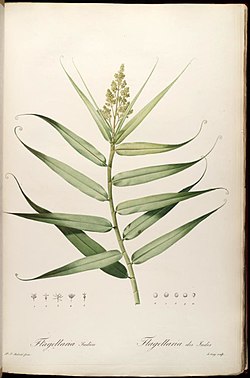| Flagellaria | |
|---|---|
 | |
| Flagellaria indica [1] | |
| Scientific classification | |
| Kingdom: | Plantae |
| Clade: | Tracheophytes |
| Clade: | Angiosperms |
| Clade: | Monocots |
| Clade: | Commelinids |
| Order: | Poales |
| Clade: | Graminid clade |
| Family: | Flagellariaceae Dumort. [2] |
| Genus: | Flagellaria L. |
Flagellaria is the sole genus in the flowering plant family Flagellariaceae with only five species. [3] The family is accepted by the APG II system of 2003 (and unchanged from the APG system, 1998); it is assigned to the order Poales in the clade commelinids, in the monocots.
Contents
Flagellaria consists of only five known species, found in the tropical and subtropical regions of Asia, Africa, Australia, and various island of the Pacific and Indian Oceans. They are vines which branch dichotomously, with each of the leaves tipped with a tendril. [4]